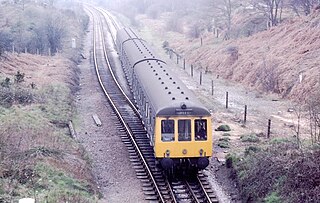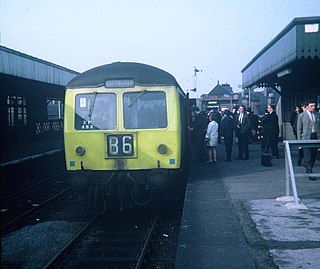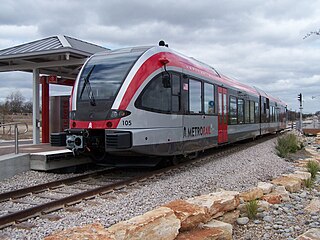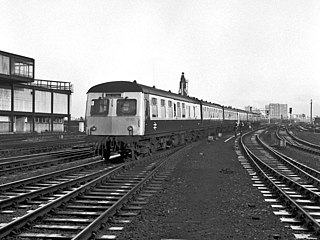
A diesel multiple unit or DMU is a multiple-unit train powered by on-board diesel engines. A DMU requires no separate locomotive, as the engines are incorporated into one or more of the carriages. Diesel-powered single-unit railcars are also generally classed as DMUs. Diesel-powered units may be further classified by their transmission type: diesel–mechanical DMMU, diesel–hydraulic DHMU, or diesel–electric DEMU.

A railcar is a self-propelled railway vehicle designed to transport passengers. The term "railcar" is usually used in reference to a train consisting of a single coach, with a driver's cab at one or both ends. Some railway companies, such as the Great Western, termed such vehicles "railmotors".

A diesel locomotive is a type of railway locomotive in which the power source is a diesel engine. Several types of diesel locomotives have been developed, differing mainly in the means by which mechanical power is conveyed to the driving wheels. The most common are diesel-electric locomotives and diesel-hydraulic.

A railbus is a lightweight passenger railcar with an automotive engine. It shares many aspects of its construction with a bus, typically having a bus body and four wheels on a fixed base instead of on bogies. Originally designed and developed during the 1930s, railbuses have evolved into larger dimensions with characteristics similar in appearance to a light railcar, with the terms railcar and railbus often used interchangeably. Railbuses designed for use specifically on little-used railway lines were commonly employed in countries such as Germany, Italy, France, the United Kingdom, and Sweden.

The British Rail Class 121 is a single-car double-ended diesel multiple unit. 16 driving motor vehicles were built from 1960, numbered 55020–55035. These were supplemented by ten single-ended trailer vehicles, numbered 56280–56289. They have a top speed of 70 mph (113 km/h), with slam-doors, and vacuum brakes. The driving motor vehicles were nicknamed "Bubble Cars" by some enthusiasts.

The British Rail Class 116 diesel multiple units were built by BR Derby from 1957 to 1961. Introduced as part of the British Railways Modernisation Plan in the mid 1950s, as with other first generation DMUs the 116 was intended to replace steam trains and reduce costs across the rail network. Alongside Metro-Cammell, BR Derby had prior experience with DMUs, having developed a Lightweight Unit, and so was awarded a contract for a new design.

The British Rail Class 114 diesel multiple units were built by BR Derby from September 1956 to July 1957. Forty-nine 2-car units were built, numbered E50001-49 for driving motors and E56001-49 for driving trailers. The units were used in the early days out of 40A Lincoln TMD (LN) on services all over the county, although a small number were transferred to 41A Sheffield (Darnall) during 1959/60.

The British Rail Classes 101 and 102 diesel-mechanical multiple units were built by Metro-Cammell at Washwood Heath in Birmingham, England, from 1956 to 1959, following construction of a series of prototype units. These classes proved to be some of the most successful and longest-lived of BR's First Generation DMUs, second in longevity only to the Class 121, with the final five units being withdrawn on 24 December 2003. The oldest set was, by then, just over 47 years old.

The British Rail Class 127 diesel multiple units were built by BR Derby in 1959. Thirty 4-car units were built, formed of two outer driving motor vehicles, sandwiching two intermediate trailers which were classified class 186. The technical description of such as 4-car unit was DMBS + TSL + TS + DMBS.

In 1933, the Great Western Railway introduced the first of what was to become a successful series of diesel railcars, which survived in regular use into the 1960s, when they were replaced with the new British Rail "first generation" type diesel multiple units.

The British Rail Class 118 diesel multiple units were built by the Birmingham Railway Carriage and Wagon Company (BRCW) and introduced from 1960. It was a licence-built version of the British Rail Class 116.
Push–pull is a configuration for locomotive-hauled trains, allowing them to be driven from either end of the train, whether having a locomotive at each end or not.

The Class 112 and Class 113 DMUs used the standard Cravens body used on Class 105s but had a single Rolls-Royce C8NFLH engine rated at 238 hp (177 kW) per car, all of which formed into 'power twins' – two car sets with both vehicles powered.

The Stadler GTW is an articulated railcar for local transport made by Stadler Rail of Switzerland. GTW stands for Gelenktriebwagen.

The British Rail Class 120 was a cross-country DMU in three-car formation, built at the British Rail Swindon Works.

The British Rail Class 124 diesel multiple units were built by BR Swindon Works in 1960.

The British Rail Class 128 was a class of diesel multiple unit, built for British Rail. Introduced in 1959, ten of the class were built by Gloucester Railway Carriage and Wagon Company, each with two 230 hp British United Traction - Albion engines. The class was built specifically for parcels, fitted out with parcel racks and bike storage at each end, and did not feature any passenger accommodation. The last members of the class were withdrawn in 1990 and broken up the following year, and none were preserved.
A hybrid train is a locomotive, railcar or train that uses an onboard rechargeable energy storage system (RESS), placed between the power source and the traction transmission system connected to the wheels. Since most diesel locomotives are diesel-electric, they have all the components of a series hybrid transmission except the storage battery, making this a relatively simple prospect.

The 900/800 class railcars were diesel multiple units built by the New South Wales Government Railways between November 1951 and November 1960.

Diesel multiple units and railcars are trains, usually with passenger accommodation, that do not require a locomotive. Railcars can be single cars, while in multiple units cars are marshalled together with a driving position either end. As of December 2010, 23 percent of the rail passenger cars used on Network Rail are part of a diesel multiple unit.

















